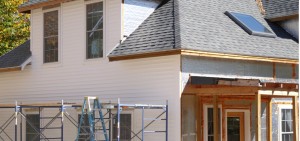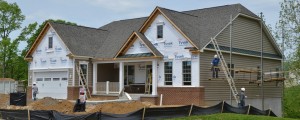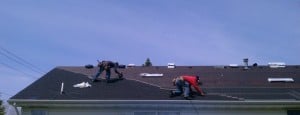Choosing the right siding makes a big difference in the way your home looks. This is an obvious point covered in our previous blog, “Choosing Sides Part 1: Vinyl Vs. Steel Vs. Cement Siding”. However, it’s an important point to keep in mind when you are designing your home’s new look.
Some of your design choices may quite literally put weight on the costs of materials and labor, such as with heavy fiber cement clapboards or shingles. Or, you may consider the ease of maintenance that vertical vinyl siding affords.
When you are considering the curb appeal and character of your home, however, you’ll need to decide between siding installation styles of vertical, horizontal or shingles. Here are some tips to help you decide.
Horizontal Siding
Horizontal siding installation is the most traditional style of the three options. Regardless of the siding material used, horizontal siding is designed to replicate wood cladding. Further, considering that roughly 80% of homeowners choose horizontal siding, horizontal siding style must be the most aesthetically pleasing, too!
However, there are other factors involved in choosing horizontal siding over vertical or shingle siding — materials, labor and weather resistance.
Vertical Siding
Vertical siding style is more commonly installed on commercial buildings, schools, libraries, retail businesses and other non-residential buildings. However, vertical siding installations are becoming more popular. Following are some of the reasons:
- Aesthetics: Vertical siding style makes a home look taller. It draws your eye to the roof. A vertical siding style makes your home stand out among others on your block, and it may be used to accent a horizontal siding installation.
- Maintenance: It’s simply easier to clean a vertical siding installation than it is to clean a horizontal siding style. Less maintenance saves time and money through the years.
- Weather resistance: It would seem to appear that a horizontal siding style would be more weather resistant than a vertical style. After all, clapboards overlap in a horizontal style, which allows water to wash straight down with gravity. However, horizontal clapboards typically don’t extend the entire length of your home. This means that seams are susceptible to lifting over time and allowing in the elements.
Vertical siding style also has a few drawbacks. The costs of materials and labor are more for vertical compared to a horizontal siding style. This is because furring strips must be installed between the vertical siding pieces to protect against water leakage and to give a level, smooth finish.
Shingle Siding
Shingle siding creates a distinctive appearance for your home that is charming, rustic and rugged all at the same time. Shingles also give your home depth that horizontal and vertical siding styles don’t.
Vinyl and fiber cement materials are most often used for shingle siding, and both replicate cedar shingles very well. In fact, it is quite difficult to differentiate between vinyl, cement fiber and cedar shingles from just a short distance.
Your design options are the same as installing real cedar, such as lap, beveled, traditional straight edge, traditional staggered edge and round edge.
If you have questions about choosing siding styles or materials, contact the professionals at Innovative Building & Design to learn more!




